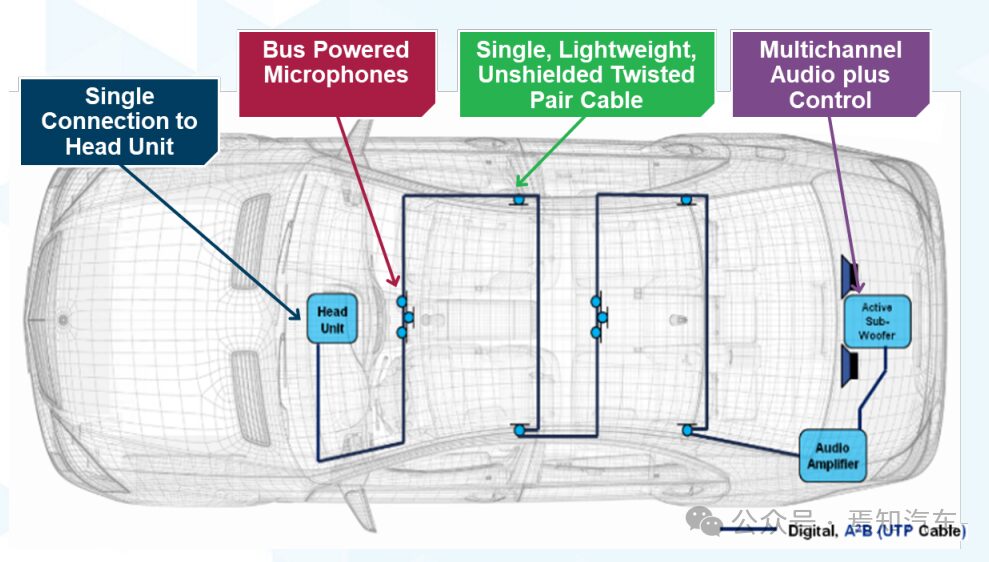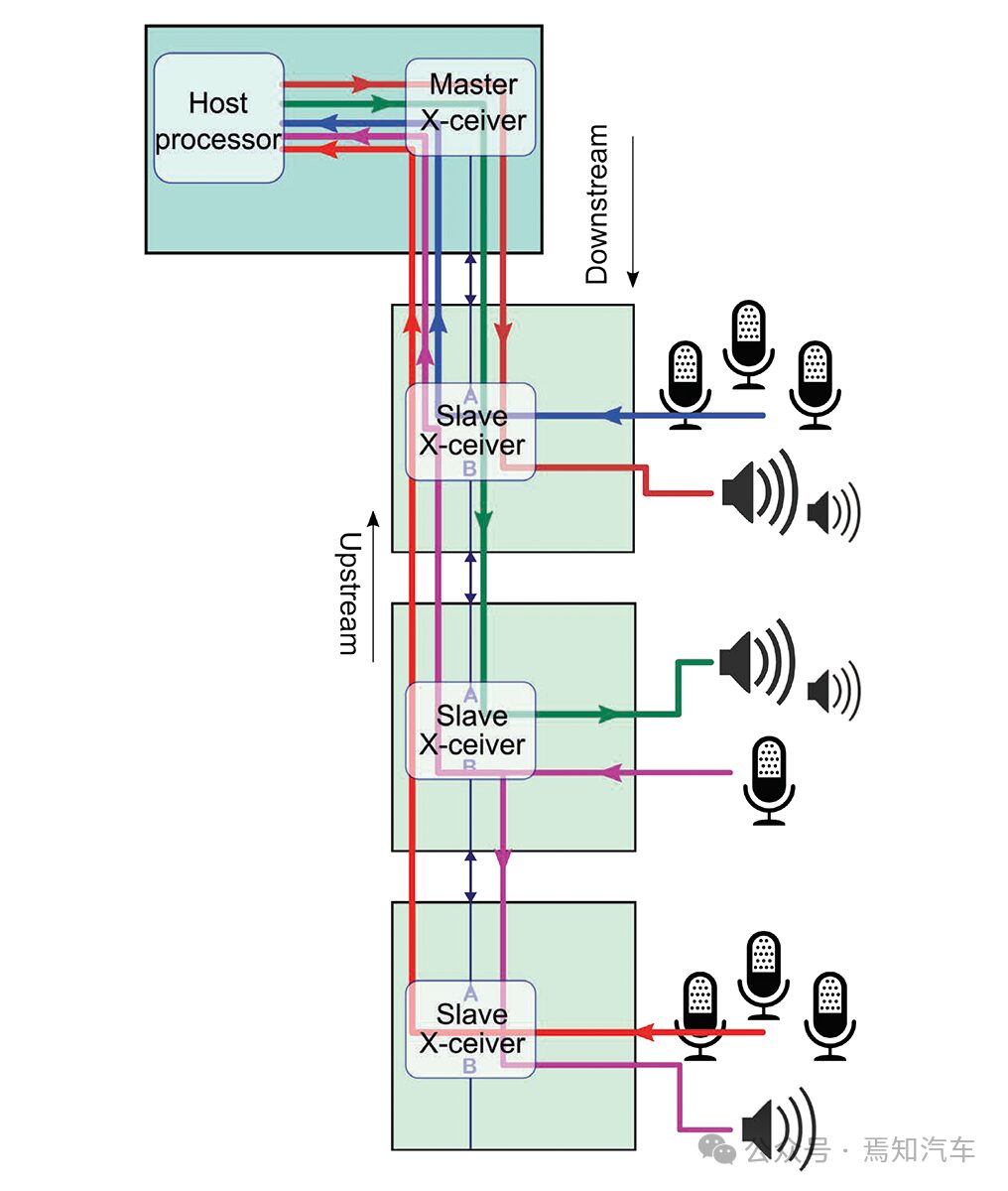
Abstract:With the continuous development of automotive technology, the functions of in-vehicle entertainment systems are becoming increasingly diverse, and the requirements for audio and video transmission are also rising. Audio Video Bridging (AVB) and Automotive Audio Bus (A2B) are two important in-vehicle communication technologies that play a key role in in-vehicle entertainment systems. This article will detail the technical characteristics of AVB and A2B, including a high-level overview, advantages and disadvantages, and applicable applications, showcasing their unique value and complementary relationship in in-vehicle entertainment system communication through comparative analysis, providing professionals and enthusiasts in the automotive electronics field with a deeper understanding of these two technologies.
1. Introduction
In modern vehicles, in-vehicle entertainment systems have become an important part of enhancing the driving experience. From high-definition audio playback to video streaming services, from the transmission of images from vehicle monitoring cameras to the realization of Internet of Vehicles functions, all rely on efficient and reliable communication technologies. AVB and A2B have emerged to meet the special needs of the in-vehicle environment, providing dedicated solutions for the transmission of audio and video data.
2. Audio Video Bridging (AVB)
(1) AVB Overview
AVB is primarily used for transmitting audio and video over Ethernet. It is implemented as a switched Ethernet network, reserving a portion of available Ethernet bandwidth for audio and video traffic, ensuring that audio and video data can be transmitted stably and smoothly in the network. It adopts a daisy-chain connection topology and can connect with intermediate AVB bridges/point-to-point connections. This topology allows flexible device arrangement in the in-vehicle network to adapt to different layout requirements.
AVB implementation is based on a series of IEEE standards, which provide a solid foundation for the standardized operation of AVB. For example, traffic is prioritized into three classes (Class A, Class B, Class C) based on maximum latency, ensuring that time-sensitive audio and video traffic is prioritized during network congestion. When fully transitioning to TSN (Time-Sensitive Networking) and limited to automotive profiles, more standards need to be adopted to further meet the automotive industry’s strict requirements for reliability and real-time performance. For instance, ADI’s ADSP SC58x/59x series supports AVB and IEEE standards, providing hardware support for AVB applications in in-vehicle systems.

(2) Advantages and Disadvantages of AVB
-
Advantages
-
Standardization Advantage: The standardized protocol by IEEE (Table 1) means that any vendor can follow the standard to implement the AVB stack. Different chipsets from various vendors have ready-made AVB stacks available, greatly promoting the market application of AVB technology, lowering technical barriers and development costs.
-
Multi-functional Transmission: Supports the transmission of audio, video, and other control data, meeting the diverse data transmission needs of in-vehicle entertainment systems. For example, it can transmit multimedia data such as music and movies, as well as vehicle control commands.
-
Flexible Conversion: Can serve as a gateway and protocol converter, enabling conversion between Ethernet and CAN/LIN and vice versa. This allows AVB to seamlessly interface with other types of buses in the in-vehicle network, integrating different electronic systems in the vehicle.
-
Scalable Bandwidth: Scalable bandwidth from 10Mbps to 1000Mbps can adapt to the bandwidth demands of different resolutions of audio and video and various application scenarios. In high-definition video transmission, higher bandwidth can be utilized to ensure smooth video playback, while in some low-bandwidth audio transmission scenarios, bandwidth usage can be reduced to improve network resource utilization.
Table 1 IEEE Standards
|
IEEE Standard Number |
Standard Name |
Description |
|
IEEE 802.1AS |
Precision Time Protocol (PTP) |
Used for precise clock synchronization between network devices. |
|
IEEE 802.1Q |
Virtual Local Area Network (VLAN) and Quality of Service (QoS) |
Allows network devices to identify and prioritize different types of traffic. |
|
IEEE 802.1Qat |
Stream Reservation Protocol (SRP) |
Used for bandwidth reservation and traffic control. |
|
IEEE 802.1Qav |
Forwarding and Queuing for Time-Sensitive Streams |
Ensures that time-sensitive data streams (such as audio and video) are prioritized for transmission. |
|
IEEE 1722 |
AVB Transport Protocol Framework and Requirements |
Defines the framework and requirements for the AVB transport protocol, including data formats and flow control. |
|
IEEE 1723 |
AVB Transport Protocol Stream Identification and Handling |
Defines the stream identification and handling methods for the AVB transport protocol. |
|
IEEE 802.1BA |
AVB System Standard |
Defines a set of preset values and settings used in the production of AVB-compatible devices. |
|
IEEE 802.1Qci |
Enhanced Transmission Selection |
Used to improve the transmission efficiency of data streams in the network. |
|
IEEE 802.3 |
Ethernet Standard |
Includes physical layer and data link layer specifications, upon which AVB technology is based. |
|
IEEE 802.3at |
Power over Ethernet (PoE) |
Although not a core standard of AVB, PoE can provide power to devices in the AVB network in practical applications. |
-
Disadvantages
-
Implementation and Integration Challenges: Implementing AVB stack software and integrating the AVB stack into platforms with a heavy set of IEEE standards requires developers to have a high level of technical expertise and rich experience, increasing the complexity and difficulty of development.
-
Lack of Tools: There are no centralized GUI tools for complete network configuration/AVB traffic visualization (currently unavailable, upcoming), which brings inconvenience to network deployment and debugging, making it difficult for developers to intuitively understand the network operating status and traffic distribution.
-
Additional Hardware Requirements: Requires microcontrollers to run the AVB stack and additional clock generators to lock PTP recovery, leading to additional bill of materials (BOM) costs, increasing the overall cost and complexity of the system.
(3) AVB Applicable Applications
-
Camera Applications: In in-vehicle camera systems, AVB can stably transmit the video data captured by cameras, whether for reversing images, driving recorders, or monitoring the vehicle’s surrounding environment, AVB can ensure real-time video transmission, providing accurate visual information to the driver.
-
Video Streaming: For in-vehicle video streaming services, such as rear-seat passengers watching online videos or local video playback, AVB’s high bandwidth and traffic priority control can ensure smooth video playback, avoiding stuttering and delays, providing a high-quality video viewing experience.
-
OTA and Gateway (when used as TSN): In the Internet of Vehicles’ OTA (Over-the-Air) update function, AVB can serve as a reliable transmission channel, quickly and accurately transmitting update data to various parts of the in-vehicle system. When serving as a gateway and applying TSN technology, it can efficiently exchange and integrate data between different networks, ensuring interconnectivity and collaboration of the in-vehicle network.
3. Automotive Audio Bus (A2B)
(1) A2B Overview
A2B transmits audio using simple UTP wires, adopting a daisy-chain topology from the master node to the slave nodes. This topology simplifies wiring and effectively reduces the complexity of in-vehicle wiring. The master node can access all slave nodes and peripherals connected to the slave nodes, facilitating centralized control and management of the audio system.
Slave nodes directly support pulse density modulation (PDM) supported microphones without the need for a host microcontroller, reducing the cost and complexity of slave nodes. Slave nodes can synchronize with the master clock, and there is deterministic time delay from the master node to the slave nodes, which is crucial for the synchronization and stability of audio transmission, ensuring accurate playback of multichannel audio. Additionally, slave nodes can be bus-powered or locally powered, providing more flexibility in power supply options.

Figure 2 Automotive Audio Bus (A2B)
(2) Advantages and Disadvantages of A2B
-
Advantages
-
Low Overhead: Lacks the overhead of IEEE standards, A2B has advantages in protocol complexity and resource utilization compared to AVB, allowing for more efficient use of system resources.
-
Easy Integration: The A2B stack is easy to integrate into common operating systems like RTOS, Linux, and QNX, reducing development difficulty and shortening development cycles, enabling automotive manufacturers to apply A2B technology to in-vehicle audio systems more quickly.
-
Network Diagnostics Support: A2B supports network bus diagnostics, allowing for timely detection of faults and issues in the network, facilitating maintenance and repair, and improving the reliability and maintainability of the in-vehicle audio system.
-
Cost and Weight Advantages: Significantly reduces cable weight and cost, which is very important for the automotive industry, as it can reduce vehicle weight, lower production costs, and minimize the space occupied by wiring in the vehicle.
-
Multi-functional Communication: A2B also supports asynchronous communication on the synchronous bus, suitable for OTA, diagnostics, and other applications, meeting the transmission needs of some non-audio data, expanding its application range.
-
Wake-up Function: Due to supporting bus power, A2B can also be used to wake applications from deep sleep, which is very useful for some low-power application scenarios, allowing for quick activation of relevant devices when needed, improving system response speed.
-
Flexible Control: The master node has a long-distance GPIO control over the slave nodes, and using GUI (Sigma Studio) tools allows for flexible design of A2B network topology, making it convenient for engineers to customize designs based on different vehicle models and audio system requirements.
-
Disadvantages
Bandwidth Limitation: Fixed bandwidth up to 50Mbps. If bandwidth needs to be increased, parallel bus connections (multiple master nodes) may be required, which somewhat limits A2B’s application in high-bandwidth demand scenarios, such as high-definition video transmission.
(3) A2B Applicable Applications
-
Radio/Audio: A2B’s original design goal was in-vehicle audio transmission, making it very suitable for transmitting radio audio signals and constructing in-vehicle multichannel audio systems, ensuring high-quality transmission of audio signals and providing clear and smooth music experiences for passengers.
-
Lightweight Application Control, Sensor Data: For some lightweight application control data and sensor data transmission, A2B can meet its bandwidth and functional requirements, such as simple sensor data collection and transmission in the vehicle, like temperature sensors, humidity sensors, etc., can be transmitted via A2B.
-
Voice Applications: In in-vehicle voice control systems, A2B can stably transmit voice data, ensuring the accuracy and timeliness of voice recognition, providing reliable communication support for voice interaction functions.
-
Lightweight OTA: For smaller OTA updates, such as audio system software updates, A2B can perform well, achieving remote upgrades of in-vehicle audio systems at low costs and resource consumption.

Figure 3 A2B Node Interconnection
4. Comparison and Complementarity of AVB and A2B
(1) Comparison
Standards and Complexity: AVB is based on IEEE standards, offering a higher degree of standardization but also bringing implementation and integration complexity; A2B lacks the overhead of IEEE standards, making it relatively simple and easy to integrate.
Bandwidth: AVB offers scalable bandwidth from 10Mbps to 1000Mbps, suitable for high-bandwidth applications; A2B has a fixed bandwidth of up to 50Mbps, suitable for medium to low bandwidth audio-related applications.
Hardware Requirements: AVB requires microcontrollers and additional clock generators, increasing BOM costs; A2B slave nodes do not require microcontrollers, providing a certain advantage in hardware costs.
Application Focus: AVB focuses on video transmission, camera applications, and its role as a gateway in the Internet of Vehicles; A2B primarily focuses on in-vehicle audio transmission and some lightweight data transmission and control.
(2) Complementarity
In in-vehicle entertainment systems, AVB and A2B are not mutually exclusive but have strong complementarity. For high-definition video streaming, complex Internet of Vehicles data interactions, and high-bandwidth applications, AVB can showcase its advantages; for audio transmission, lightweight control, and sensor data transmission, and scenarios with high cost and simplicity requirements, A2B is a better choice. For example, in a high-end in-vehicle entertainment system, both AVB and A2B can be used simultaneously, with AVB responsible for video playback, camera image transmission, and high-speed data exchange with external networks, while A2B focuses on constructing the audio system and transmitting simple in-vehicle sensor data. Both work together to create an efficient, stable, and feature-rich in-vehicle entertainment communication system.
5. Conclusion
Audio Video Bridging (AVB) and Automotive Audio Bus (A2B) play irreplaceable roles in in-vehicle entertainment system communication. AVB, with its standardization, high bandwidth, and multifunctional conversion advantages, occupies an important position in video-related applications and the Internet of Vehicles; A2B excels in audio transmission and lightweight data applications due to its low overhead, ease of integration, and cost advantages. By reasonably applying and integrating these two technologies, automotive manufacturers can build more advanced and reliable in-vehicle entertainment systems that meet diverse user needs, providing passengers with richer and higher-quality in-vehicle experiences. As automotive technology continues to evolve, AVB and A2B technologies will also continue to evolve and improve, continuing to play an important role in the future of in-vehicle communication, driving in-vehicle entertainment systems towards higher performance and more diverse functionalities.
